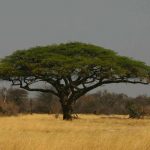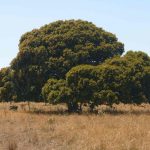TREE LIFE
November 1986
MASHONALAND CALENDAR
Tuesday November 4th: Botanic Garden Walk. Meet in the car park at 1645 for 1700hours for a stimulating evening’s walk in Harare’s veritable Eden.
Sunday November 16th : An outing to the farm of Shirley and Tony Leatt, Concession. Anyone who has been up to Mvurwe/Centenary will have noticed the interesting kopjes in the area around Concession. I think of them as being one of the head quarters for Hymenodictyon, though these will be well past their prime. ` Total distance from Harare is about 53km. A bus has been hired which will leave at 0845 from Monomatapa Car Park where the usual security guard will look after vehicles left there. The fare is $13.
MATABELELAND CALENDAR
Sunday November 2nd : We will go to the Matopos to Whitewaters Area. Meet at Retreat at 0830 but arrange cars beforehand, and bring lunch.
On Sunday October 5th we went to the Circular Drive near the Radio Mast and found some 50 species in a fairly short outing. The area was very rocky and broken which no doubt, had discouraged builders to our present benefit. There were some splendid views. Among the trees we saw were Acacia gerrardii, Albizia antunesiana in flower, Bridelia mollis, Burkea africana, Canthium lividium, Carissa edulis flowering, Cassine matabelica also flowering, Cussonia natalensis, Diplorhynchus condylocarpon handsome in new leaf, Dombeya rotundifolia with flowers well bronzed, Erythrina latissima very bare, Euclea divinorum only one or two Euclea natalensis, many Ficus glumosa, Ficus ingens, Grewia monticola and what we thought was Grewia bicolor Lannea discolor, very bare, Maytenus heterophylla, Maytenus senegalensis and Maytenus undata without any podery bloom Ochna schweinfurthii,
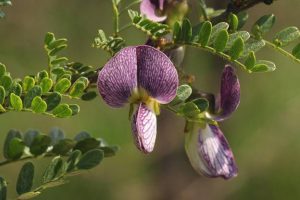
Ormocarpum trichocarpum. Photo: Bart Wursten. Source: Flora of Zimbabwe
Ormocarpum trichocarpum, a rather old looking tree of nearly 3 meters, Osyris lanceolata, Ozoroa insignis subsp. reticulata, some with smoother leaves, Pappea capensis, with spiny toothed leaves, Pavetta schumanniana many, two Pouzolzia hypoleuca one really just a bud, Protea gaguedi, Pseudolachnostylis some very small, Pterocarpus angolensis, Rhus lancea in fruit, Schrebera alata, also fruiting, Strychnos spinosa in bright new leaf, Tapiphyllum velutinum, very decussate, very soft and bark below very red, Terminalia sericea, Terminalia trichopoda, Turreaea nilotica in fruit, Vitex payos, quite young, Ximenia caffra, Ziziphs mucronata.
—C.Sykes
WEDZA MOUNTAIN – 19TH OCTOBER 1986
What is Wedza Mountain? Wedza is amongst one of the oldest rock formations in Zimbabwe. In its formation periods of volcanic activity alternated with periods during which sediments of what is now banded ironstone were deposited on top of this solidified larvae. Many years later all these layers were buckled and twisted when huge volumes of molten magna welled up into the earth’s crust and solidified before reaching the surface. This ancient surface has long since been eroded away exposing these solidified magnas which we see as gneissic rock and granite dwalas. The layers of banded ironstone are much more resistant to weathering than the surrounding gneiss so stick out 500m above the present countryside and form the high peaks of Dangamvuri (1789m) and Romorshoto (1760m). The folding of this dense banded ironstone was well illustrated at the top of Romorshoto where we stood to survey the view, particularly the Save River which winds around the southern portion of Wedza called Gandamasunga, and then flows south east along a fault line in the granite. In some areas the broken bits of ironstone have rusted together with ferricrete and often the ironstone itself shows signs of rust. In the saddle between Romorshoto and Dangamvuri we found soapstone which represents the volcanic layers that lie in between the banded ironstone. Further south in Gandamssunga the volcanic rock between the banded ironstone is not soapstone but was originally dunite that was reheated and metamorphosed to form serpentine similar to that of the Great Dyke. According to Wild the soils in this area have 7300ppm Nickel and 10120ppm Chromium.
Why is the vegetation interesting? In some areas the geology is the most important single factor affecting the vegetation. The toxicity of the serpentine excludes the growth of trees with the exception of a few stunted Combretum molle as we saw on Gandamasunga as the bus approached the mountain from Garaba Store. But even here, when a lot of water is present, this toxicity is overcome. Water seems to dam up behind layers of banded ironstone and then flow over the top. In these wet areas are gallery forests consisting of Syzygium with Bridelia micrantha and Ficus thonningii, with fruit that sticks out on peduncles longer than 5mm.
On much of the mountain the relief seems to be more important than the actual chemical composition of the rock itself. Up on Romorshoto we stood in the breathless October heat and noted the stunted vegetation around us. There we found Philippia hexandra and shrubby specimens of Rapanea melanophloes, a species that grows in riverine vegetation on the Eastern Highlands and on the Great Dyke. Its presence is surely related to altitude and rainfall and not the banded ironstone. Nuxia congesta also grew as a stunted shrub with deformed leaves. On a sunny day these specimens looked out of place although on the recce David Hamilton, Meg and I stood here in an icy wind with streaks of cloud passing around us. This cold wind may also explain why so many of the Brachystegia branches are so twisted and knotted. During favourable conditions growth proceeds normally, but every now and again the growing buds are frosted and die. Growth begins again from a lateral bud. Here amongst these gnarled trees the lichens grow in profusion hanging from the branches in curtains. The branches are also thickly coated with mosses and orchids. Other Eastern Highland elements that grow near the peak as a result of the altitude and rainfall are Myrica pilulifera, in bright green leaf, and Protea petiolaris, a striking tree with long drooping leaves and pink petioles.
The road to Rommorshoto : There are two roads to Wedza we travelled there along the route stated in last month’s newsletter and returned via Gloucester Road, Watershed Road and Finches Road. The first route is very scenic with many low level bridges that must be a nightmare in heavy rains. On route the Burkea africana were laden with flowers. In the communal land beyond Wedza many of the trees have been cut down but magnificent Ficus sycamorus display an interesting browse line and Maureen spotted a Securidaca longepedunculata in full violet flower, so we stop the bus on the way home. Many Haemanthus were in flower and added a bright red touch to the landscape. We took the bus as far as Nyamatonora Dam and boarded the land rovers for the ascent. At this point I must thank David Hamilton for making the trip possible. Not only did he make arrangements with the local council and provide a guided recce, but he also chauffeured folk up and down the mountain, fetching and carrying when I am sure he would have preferred to have been with us. Secondly, thanks to Vida Siebert for organizing the second land rover enabling all of us to get to the top.
The trees : Those of us who ascended in the second group began botanizing along the road where huge
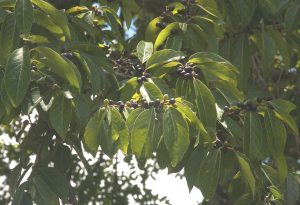
Bridelia micrantha. Photo: Bart Wursten
Bridelia micrantha dominated the riverine forest. I was transported back to Table Mountain with the discovery of Rhoicissus tomentosa, Diospyros whytaena and Ilex mitis. Alec found very holly like leaves near the base of Ilex, but without these clues I find the grooved midrib a useful feature. Although many were impressed by the brown furry edge and shiny green leaf of D.whytaena, no one found ripe seeds. Cheryl germinated seed collected in April last year from Springvale. The R.tomentosa is a simple leaved member of the grape family, VITACEAE, and it clambers over other trees and shrubs, supported by means of its long tendrils. I spent a few frustrating hours puzzling over a Heteropyxis that did not smell, and just when I was extolling the benefit of family characters when one did not know the species, the opposite decussate arrangement and sub marginal vein obviously indicated MYRTACEAE – Meg declared it to be our friend Olinia vanguerioides of the OLINIACEAE, family in the Myrtales and right next door to MYRTACEAE. The other plant that caused a stir was Choristylis ramnoides of the ITEACEAE. Prof. Wild planted this species outside my office but for years I had overlooked it as a Rhamnus. There are clear differences though the leaves of Choristylis are rounder and have lateral veins that are pinched where they join the midrib.
The mornings walk started at Romorshoto and ended at the Shaelite Mine on the south eastern slope. The descent was quite steep in places and although Jessica is no longer a light weight, suggestions that we stop feeding her to lighten the load have not met with approval. I have mentioned most of the trees we saw although Trema orientalis and Cussonia spicata were another two rarities.
Again being in the tail group gave us time to examine the riverine forest near the mine. We have had trouble with two members of the OLEACEAE. Olea capensis and Chionanthus battescombii, linociera. Both have the typical olive appearance with pale twigs and opposite decussate leaves. Generally Chionanthus has stiffer leaves with acridomatia. Olea leaves hang more, are often narrower and lack acridomatia. We decided these were Olea capensis although Tom says the purple petioles on the Olea are a helpful clue. The C.battascombii in the Botanic Gardens are in full fruit and these look just like olives, the same size and colour. It would be interesting to try soaking them in brine.
Also in this patch are Strychnos mitis, Scolopia zeyheri, Fagaropsis angolensis and Crabia brevicaudata. On the Botanic Garden Walk Tom showed how the bark of S.mitis is so thin it can be scratched off with a fingernail. S.zeyheri is probably more common than we realize, at Wedza it does have the waxy cuticle that lifts off when the leaf is bent. Fagaropsis is the only indigenous RUTACEAE with opposite leaves.
We returned to the bus for lunch and to provide entertainment to the sea of faces that obviously found our behavior amusing. After lunch there was not much time before we left and so we examined the plants close to the bus. Here we found Dovyalis zeyheri, Ekebergia capensis and Pterocarpus rotundifolius.
Wedza the future : The local council has considered declaring Wedza Mountain a protected area. This would require fencing the mountain and controlling grazing in paddocks. The tourist potential also needs to be realized although for this the road probably needs repair. The chopping of wood which is being carried down the mountain by sleigh also needs to be controlled. Conservation of Wedza will also reduce the siltation of dams and rivers in the area.
–KIM DAMSTRA.
As promised in our last issue, here are short notes on the history of Tree Society’s involvement in the Lake MacIlwaine Arboretum and Binga Swamp Forest as well as the Mukuvisi Woodland. The committee would welcome debate on these issues, suggestions from members as to what future projects they would like to undertake, or any assistance members would like to offer in maintaining these interests.
LAKE MacILWAINE ARBORETUM
In 1938 Sir Robert MacIlwaine, in a report to the Natural Resources Commission, noted with horror the amount of timber already cut out on Signal Hill, near the dam wall.
Twenty years later the Tree Society, then under the Chairmanship of Mr David Bentley and greatly assisted by Mr. Jack Reid, Vice chairman at the time, Mr. Trevor Gordon and Mr. Ralph Palmer, all old established members, decided to act and the latter two were able to bring in labourers to assist. Mr. Reid, a surveyor by profession, in his own leave, surveyed the side of the hill so that contours and paths might be created, which they were, eventually right to the top of the hill. Mr. Douglas Aylen supervised the selective thinning out of trees and bushes in this area leaving the bigger and more interesting trees room to spread and grow, which through the years they have most definitely done. Finance was also raised by the Society to install a ram and a 2000 gallon tank which could fill from the lake, thus allowing some of the trees and also exotics at first planted but later allowed to go their own way, to grow. A wooden shelter providing some seats and a room in which to lock tools etc. was built and later toilets and, finally, “Doug’s Seat” from which we can all survey the achievements. Thus the older members of long standing have seen much of their project achieved.
The Arboretum is a part of the National Park and, until their retirement, Parks Warden Douglas Newmarsh and the Water Bailiff, Col. Kemp kept an eye on it. In recent years fewer visits have been made to the Arboretum and the society has placed more emphasis on education and conservation through education. The Lake MacIlwaine Arboretum is in an unsuitable position for such teachings, whereas the National Botanic Gardens and the Mukuvisi Woodlands can be used very successfully. This was demonstrated well when we hosted the Wild Life Society in the Gardens for the second time and taught high school teachers in the Woodlands. Meg has also put much time and effort in preparing a key for the woodlands which we hope to experiment with soon. These projects should not be abandoned while we try to revive the MacIlwaine Arboretum.
BINGA SWAMP FOREST, ARCTURUS
Binga Forest lies a few kilometers west of Arcturus Village and is part of Mr. Peter Tselentis’ farm, Mount Olympus. It may be approached on a rough, uneven road from the Arcturus Road.
This area is about 3.5 hectares in extent almost in a very shallow basin, permanently wet swamp, though dry towards the verge. The trees, bushes and also ferns which grow there are entirely different to the vegetation of the surrounding grasslands and kopjes. Such forest is rare or entirely absent near Harare but its existence is threatened by the exotic Mauritius Thorn, Caesalpinia decapetala which, without constant cutting back and above all constant weeding out, would entirely engulf the area. Had it not been for members of the Tree Society, it would have been doomed.
This Binga Swamp Forest dependent on the retention of swamp conditions is protected under the Natural Resources Act. In addition to the N.R.B.s overall acknowledgement of its existence and the desirability of preservation, the Arcturus Rural Council and the Henderson Research Weed Unit have assisted in Binga’s preservation so far.
The maintenance of Binga is less demanding than it was. Stan Carey, who lives in the area, keeps an eye on the situation and has organized labour to weed the forest. He assures us that he will call on us when weeding is required and the Boy Scouts have also volunteered their assistance. Can I sincerely encourage all members to make themselves available for this task, it would be a great pity to see the forest overrun once again.
MUKUVISI WOODLANDS
During the 1960’s the late Douglas Aylen on behalf of the Tree Society conducted a tireless and sustained campaign for the preservation of the Mukabusi Woodlands. Through letters and articles in the press and by correspondence with numerous individuals and organizations, he did his utmost to create public awareness of the dangers of misuse of the area. This interest and hard work continued until the Commission of enquiry, led by Judge Pitman, upheld the objections to turning the Woodlands into a Housing Estate, and thereafter with suggestions as to the best way to utilize the Woodlands. Subsequently, what is now the Mukuvisi Woodland Association was formed and this body is now responsible for the project. Tree and vegetation surveys have been undertaken in the past and the Society is currently working on a leaf key to aid identification of the trees and shrubs; a contribution towards their education aspect.
The Committee is indebted to two articles both published in the Zimbabwe Science News, in August 1979 and September 1980, for information on both the Arboretum and Binga and also an article in Tree Life, No. 19 of 1981 and Science News Volume 13 No. 3 and Tree Life No. 17 have supplied the information on the Mukuvisi Woodlands.
And from a member in Chimanimani comes the following note :
“In connection with the foot note in the September Newsletter would members be interested to know there has been an arboretum here since 1953. In that year the local Horticultural Society accepted the lease of 31 acres from the Government for their project. A competition was held for the lay out. 28 entries were received from 9 countries and the winner was a firm of Landscape Artists in Leeds. By 1960 the area was fenced, a storage dam constructed, two pools formed in the stream, paths demarcated and 220 trees planted. From then till a few years ago interest waned. Now, however, the place is owned by the Rural Council and is in the care of the Manager, Charter Estate of Border Timbers Ltd and planting is proceeding.”
Yours sincerely, Wendy Bullock.
KEY TO THE MUKUVISI WOODLANDS
If you have never used a tree key before and don’t know all the indigenous trees then you are just the person we want to help us. Meg’s key needs to be tested in the field and volunteers are needed, it promises to be both a pleasurable and yet rewarding morning for all concerned. Please join us, even if you do know all the trees, meet at Meg’s house, 12 Kariba Crescent, at 0900 hours on Saturday 8th November.
CELTIS AFRICANA – MEAN ANNUAL INCREMENT MEASURED IN ONE INDIVIDUAL PLANT
In May 1986 I was obliged to cut down a young Celtis africana, white stinkwood, roots of which were a threat to house foundations.
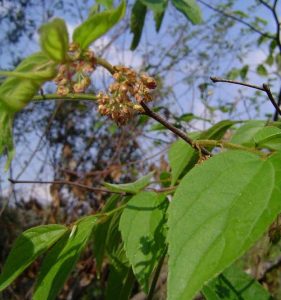
Celtis africana. Photo; Bart Wursten. Source: Flora of Zimbabwe
Planted out as a first year seedling about 10cm in height in December 1973 it was approximately 13 years of age and had reached a height of about 7.5m, no attempt was made to train or prune it, for the first few years it received a certain amount of dry season water but for the last 10 years it may be said to have grown on rainfall.
Soil conditions ; generally poor silty soil over some kind of felspathic sub soil marked by a pebble hard pan at about 1.5m depth.
When felled it gave a bulk of approximately 0.162055 m3, this figure excluding brushwood capable of use as fuel One third of this volume was timber in the round capable of being sawn into short planks, the remainder good poles.
Averaged over thirteen years this gives a mean annual increment of 0.016219 m3. Naturally most of this increase was gained in the latter years of its life.
It is difficult to visualize a plantation of C.africana measuring one hectare, but if the results of this one tree are multiplied to give a hypothetical mean average increment on a postulated 4 m spacing at 600 trees to the hectare, this would give over the same period an annual increment of 7,571400 m3.
This hypothetical figure is ten times greater than the normal accepted figure for annual increment of both Baikiaea in the forests of Matabeleland, and Brachystegia and mixed genera on the Mashonaland Highveld.
Generally speaking I both dislike and distrust bare statistics but in having to sacrifice this little tree I thought it a good opportunity to produce some figures which might mean something or nothing except to add one further piece of evidence to that canard we so often still head – indigenous trees grow so slowly.
Some might say that it was a waste to plant this tree where we did but for over ten years we got both shade and pleasure of watching it grow, many birds took advantage of both fruit and a more varied insect life than they would normally expect in a suburban garden, a sister tree is still growing in the garden where it may be trusted not to push our house over.
George Hall
KIM DAMSTRA CHAIRMAN


